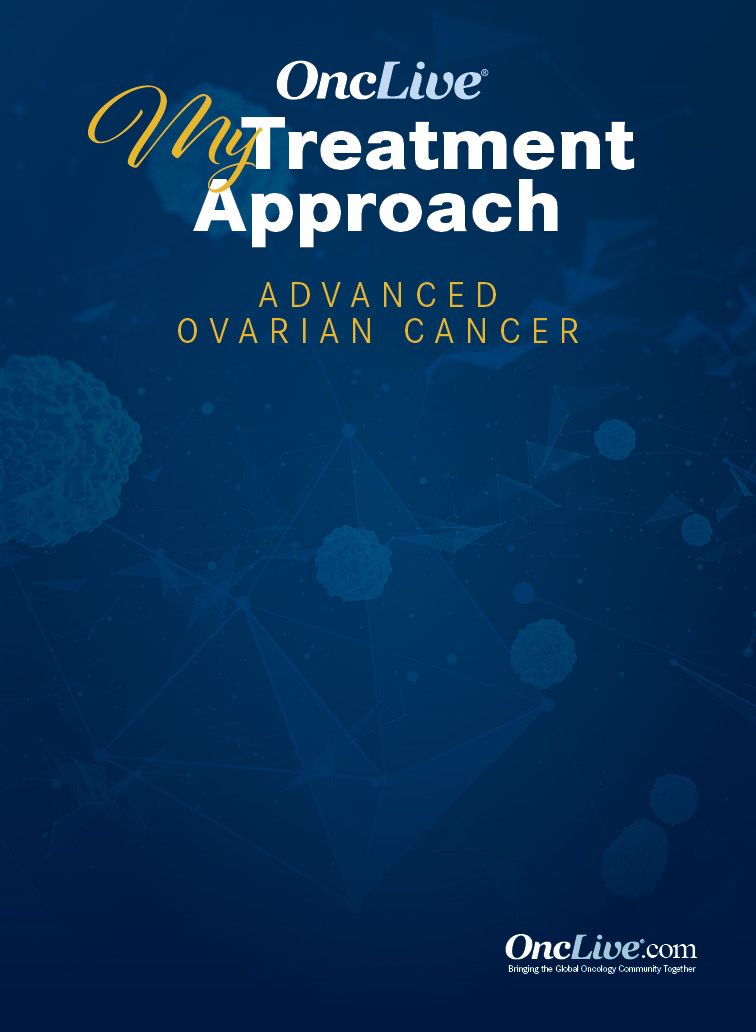Publication
Article
HRD Status Drives Decisions With Frontline PARP Inhibition in Advanced Ovarian Cancer
Author(s):
Anil K. Sood, MD, provides insight into his approach toward the frontline maintenance treatment of women with advanced ovarian cancer.
Anil K. Sood, MD

Although niraparib (Zejula) is approved as frontline maintenance therapy for women with advanced ovarian cancer regardless of biomarker status, the agent should be reserved for women with homologous recombination–deficient (HRD) tumors, explained Anil K. Sood, MD. He added that bevacizumab (Avastin) alone should be a consideration for women with homologous recombination–proficient (HRP) disease.
“Once we have all [the genetic] information, if there is a BRCA mutation, either a germline or somatic [mutation], or HRD, then we consider using a PARP inhibitor for maintenance once the up-front treatment is completed. If there is no such defect, then we consider using bevacizumab or no treatment in the maintenance setting,” said Sood.
Such recommendations are based, in part, on f indings from the phase 3 PRIMA trial (NCT02655016), which randomized 733 patients with newly diagnosed, advanced ovarian cancer who responded to frontline platinumbased chemotherapy 2:1 to receive niraparib (n = 487) or placebo (n = 246).1
The results showed that among patients with a BRCA mutation, the median progression-free survival (PFS) was 22.1 months with niraparib vs 10.9 months with placebo (HR, 0.40; 95% CI, 0.27-0.62). In those with HRD-positive tumors who were negative for BRCA mutations, the median PFS was 19.6 vs 8.2 months, respectively (HR, 0.50; 95% CI, 0.31-0.83).
In patients with HRD-negative tumors, the median PFS was 8.1 months with niraparib vs 5.4 months with placebo (HR, 0.68; 95% CI, 0.49-0.94).
In an interview with OncLive®, Sood provided insight into his approach toward the frontline maintenance treatment of women with advanced ovarian cancer. He is professor and vice chair for translational research in the Departments of Gynecologic Oncology and Cancer Biology; co-director of the Center for RNA Interference and Non-Coding RNA; director of the multidisciplinary Blanton-Davis Ovarian Cancer Research Program; and co-director of the Ovarian Cancer Moonshot Program, all at The University of Texas MD Anderson Cancer Center.
OncLive®: How have the approvals of PARP inhibitors as frontline maintenance shaped your initial discussions with patients with newly diagnosed advanced ovarian cancer?
Sood: It’s been a remarkable development for patients in a lot of ways. The options are becoming more and more complex. From the very beginning, we really try to discuss with patients what their whole treatment plan may look like, so they’re prepared as they get to different aspects of their treatment. [Those options] include personalizing their treatment in the up-front setting toward surgery vs using neoadjuvant chemotherapy. That’s when we start the discussions about what possible maintenance strategies may look like and how we would make good decisions around those [options].
What is unique to your practice when it comes to frontline maintenance therapy?
We have a number of ongoing studies looking at novel drugs in this setting. Also, we have a second-look assessment study; this was done quite a bit in the past but was stopped in the late 1990s. In the current setting of new drugs, etc, the group here is testing the utility of second-look assessment using laparoscopy.
What is the single most important aspect of care for you when it comes to frontline maintenance therapy?
In my view, genetic testing is the single most important aspect, since that helps to personalize [treatment] approaches. In some parts of the country, the testing rates are still quite low.
How does genetic testing influence the type of maintenance treatments you offer?
Ovarian cancer is an incredibly diverse disease. For all patients with high-grade serous and endometrioid disease, we offer up-front germline genetic testing, especially around BRCA1 and BRCA2 genes. About 15% to 20% of women will have a germline mutation. Now, if they don’t have a germline mutation, then we also do tumor testing or somatic testing for BRCA mutations [and] HRD.
Do any distinguishable features among niraparib, olaparib (Lynparza) alone, and olaparib plus bevacizumab help with your treatment recommendations?
The PARP inhibitors overall seem to have comparable efficacy, [with] some differences in their adverse effect profiles and in the duration of the maintenance therapy. In our group, there is some variation [in what is recommended]. In the up-front maintenance setting, either olaparib or niraparib can be used, and our practitioners have used [both].
Are patients more drawn to one PARP inhibitor over another?
It’s worth having a conversation [with patients about this]. Either [niraparib or olaparib] is a valid option. Patients are incredibly empowered these days; they come well informed. Typically, [we will have] a conversation weighing the pros and cons of either of the PARP inhibitors, the duration of treatment, and so on.
In what situations would you add bevacizumab to frontline maintenance therapy vs not adding it?
In patients with high-risk disease—such as those with distant metastases, residual disease after surgery, etc— we would consider adding bevacizumab and then using it in maintenance.
Might certain toxicities sway you away from a particular agent?
There has been some concern around platelet counts, especially with niraparib, but as we have adjusted the dosing based on weight and platelet counts at baseline for a given patient, that perhaps has been a bit better now.
If somebody has really struggled with blood counts during their treatment, we would perhaps use a PARP inhibitor rather than niraparib. But apart from that, no [particularly] great baseline markers [influence our selection].
Do you still use a PARP inhibitor if a patient doesn’t have germline or somatic abnormalities? It’s FDA approved in that setting. However, in my view, the absolute magnitude of benefit in that setting tends to be smaller, and that’s why we don’t routinely use a PARP inhibitor in HRP settings.
You said that for a patient whose tumor is HRP, you would be less likely to prescribe a PARP inhibitor. Is that because you would be concerned about exposure downstream?
In an HRP setting, typically, we wouldn’t really use a PARP inhibitor much at all unless somebody has a very long progression-free interval before they have relapsed disease. In that setting, for someone who has platinum-sensitive relapsed disease, following platinum-based therapy, a PARP inhibitor certainly can be used. Still, if such a long interval has occurred, even if a PARP inhibitor was given up front, not a lot of data are [there]. However, some emerging data [suggest that] repeat exposure to a PARP inhibitor could be considered in patients who have particularly long intervals.
What questions will be important to explore in this setting moving forward?
Patients who have HRD tumors, overall, seem to derive benefit from PARP inhibitors. But, even in that setting, not every patient with a BRCA mutation or HRD derives benefit. Trying to understand what’s different in those patients—at a biomarker level and mechanistically—and why they don’t get as much benefit [is important]. Could other drug combinations be considered in that setting?
Another very important space is patients who have HRP disease. We’re trying to see if rational drug combinations with PARP inhibitors could be used where the PARP inhibitor, or at least the combination, could work well for disease control for extended periods of time. There is also some thought that these drugs may combine well, for example, with certain immune drugs. But the data are very early, and those kinds of combinations are being tested and developed further. We still need to understand and develop [a great deal] in all these areas.
There had been a lot of interest in considering maintenance strategies, but only over the past 7 years or so have the maintenance strategies really shown promise and begun to be increasingly used. It’s certainly an exciting time given all the new drug development that’s occurring. Although the PARP inhibitors and bevacizumab have been important developments, we certainly hope for a lot more opportunities.
[To that end], we’re working on a large-scale clinical trial that would be under an adaptive trial mechanism. It would offer opportunities for drug development in the maintenance space, and there would also be opportunities for patients with relapsed disease. In my view, this up-front maintenance environment is so important, and that’s why we are really excited about this adaptive clinical trial design and [are] looking forward to launching this kind of clinical trial within the next year.
Reference
- Monk BJ, Gonzalez-Martin A. Efficacy of niraparib therapy in patients with newly diagnosed advanced ovarian cancer by BRCA and homologous recombination status: PRIMA/ENGOT-OV26/GOG-3012 study. Presented at: SGO 2020 Annual Meeting; March 28-31, 2020; virtual. Abstract 31.










